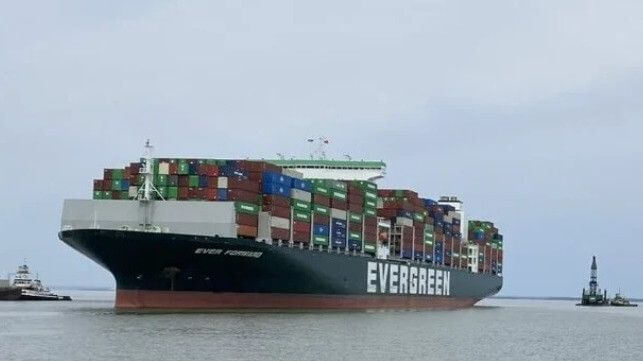Video: Second Attempt Fails to Pull Ever Forward Out of the Mud

The salvage teams were optimistic that today's weather conditions in the Chesapeake Bay would be more favorable for a second attempt to pull the Ever Forward from the mud back into the shipping channel. However, they were again unsuccessful as the ship refused to move.
A spokesperson for the U.S. Coast Guard overseeing the operation and the unified command reports that they believe nothing significant changed today. "It remains largely the same," they reported as the tugs gave up and returned to Baltimore.
The dredges had resumed operation yesterday after the first attempt to pull the vessel free failed. Experts pointed to unfavorable weather conditions with strong winds blowing water out of the Chesapeake Bay yesterday, while others questioned if they had enough power on hand to strong-arm the vessel free. In February, for example, the rescue of a Maersk container ship grounded in Bremerhaven used eight or nine high-power tugs to apply brute force to free the vessel.
Yesterday's effort for the Ever Forward used five tugs. Two were pushing on the starboard side, two pulling from the port side, and one long pull from the stern. After the further dredging around the vessel, they added two additional tugs for a total of seven scheduled to begin around 6:00 p.m. today, coordinated to the tide. With the wind turning to the southeast, they also expected additional water to be pushed into the bay to aid their efforts.
By 8:30 p.m. local time, they had again given up, and the tugs departed for Baltimore. According to the Coast Guard, the plan is to resume further dredging. The tentative plan is to attempt the next refloating of the vessel on April 4, but the exact number of tugs and configuration remains to be determined.
The efforts have become a local tourist attraction with television news helicopters circling overhead, reporters stationed onshore, and curious onlookers watching what they have started to call "Evergreen Island."
If the next attempt to refloat the vessel is not successful, reports indicate that they would start to reduce the ship's weight. Ballast was already being adjusted before the first effort to free her. They could also begin to pump fuel from the vessel or attempt to begin offloading containers in a more complicated effort. To remove containers would require heavy lift cranes being placed alongside and barges to receive the containers. Experts point out that removing cargo would be a slow process.
